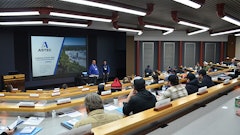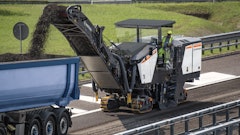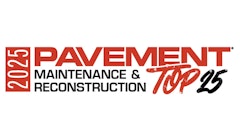
A year ago, the Buck Brothers were in a different place. They were pretty sure that they wanted to add a milling machine to their yard, but they hadn't pulled the trigger just yet. All the math looked good, and they had become far too busy to keep subcontracting out for their future milling needs. That didn't make the enormous investment any easier, or smaller, to swallow.
During a panel discussion at the 2023 IGNITE conference, Chad Buck had mentioned his two son's desire to make the move. "I'm trying to get retired," he told the crowd of other pavement professionals in attendance. "They want to spend a million dollars or something, and get this milling machine, and we've never done that before."
It's never a decision to be taken lightly. After plenty of research, shopping around, and some training with other experienced contractors, they bit bullet. They acquired a Caterpillar PM820, which can mill up to thirteen inches deep, and has 815 hp which puts it into a high enough class to be above the emissions level, not requiring DEF testing.
Throwing down for their new highway class milling machine wasn't the end of their vision, or ambition, because the plan was always to push the mill's capabilities to the next level.
 Jacob Buck
Jacob Buck
3D Milling: The Basics
Earlier this summer, I received some very limited training on a Wirtgen 200 Fi, and when I say, "Limited training," I mean that I was allowed to do a single pass in a straight line for about twenty-five feet. I was grateful for that experience, and, in all honesty, that's about as much as I would have let me do too. But I was definitely anxious to get some more time at the controls when I could. That's when Jacob Buck reached out to me, and asked if I knew anything about three-dimensional milling.
I decided that I should go and see for myself what the Buck Brothers were getting into. They were as new to the process as I was, having just got into milling in general, the addition of a totally new layer of complexity seemed like a gamble. The day I joined them on the jobsite, was the first time they were giving the 3D milling set up a go.
"It's our first year doing it," said Jacob Buck, VP of Buck Brothers standing next to their new behemoth. "So far, we're really satisfied with it."
The components they purchased in order to do 3D milling with Trimble can all be acquired separately, but they need to work in concert to produce the desired machine grade control:
- Total Station Tripod
- Data Collector and Target on a rod with Trimble SiteWorks
- Machine Display on the mill with Trimble RoadWorkds 3D
- Machine Target ECM and Radio
- Trimble Business Center (to build the 3D model)
That might seem like a lot of different pieces of the puzzle, not counting the mill itself, but the benefits of 3D can be quickly understood. While everyone is familiar with a tool like the global positioning system (GPS), machine grade controls for 3D milling require something much more refined and accurate. Universal Total Station (UTS) provides a much more refined level of specificaiton.
 Several Trimble components work together to provide precision milling.Jacob Buck
Several Trimble components work together to provide precision milling.Jacob Buck
"GPS is not nearly as accurate as UTS. GPS has roughly golf ball sized accuracy, versus UTS which has millimeter level accuracy," said Buck. "So whenever we're fine grading something, whether it be with our greater blend on skid steer or this, we know that it has to be UTS."
What does the process look like? It begins on the site before any of your heavy iron gets there.
"What we do before the job starts is we'll come out here, survey it using the total station and a rod with a data collector, and then bring that back to the office. We'll make a model of the job, optimize it, smooth it out, and make sure there's no water holding anywhere. After we're done, then we come out here and we put that model into the machine. Basically, the goal is that we want to mill this to grade, so that when we come to pave it, we can shoot sonics off of it and there will be no water."
Once the 3D model is in the machine, and the automatics are set, the operators can focus on driving the mill and directing the conveyor system, and the mill will automatically direct itself according to the pre-designed model.
3D milling is especially effective at fixing and repairing the liabilities of preexisting pavements, a big benefit and selling point to potential clients. When trying to remove areas where potholes developed or water pooled in large sections, it is almost always an issue with what is underneath the asphalt.
To properly deal with this issue when you've been hired to resurface means getting down below and regrading the base material to prevent a repeat scenario when you repave fresh wear-layer overtop. It's not usually a matter of inches, however, that's why the UTS accuracy is so vital, because a contractor using 3D can make the careful adjustment and get a big result and a happy customer.
Boom In Business
The Buck Brothers knew there was demand for milling services beyond their own needs, but they didn't exactly know just how big the demand was going to be. The result has been a serious expansion of their business, more than they had even anticipated.
"We are getting like five hundred calls a week," said Buck. "People think I'm bull-shitting them, but I'm not. We've adopted a new software so that everything in the background is running a lot smoother. It's been the biggest game changer."
While demand for their services was scaling up, it was vital that they realized their need to scale up the behind-the-scenes workflow to help them manage everything. The Buck Brothers utilize HubSpot for their customer relationship manager (CRM) needs, and OneCrew for everything else. It didn't just help them scale up their capabilities, but it helped them quantify what kind of scaling and where they needed it most.
"If I didn't have it, we'd just be guessing, right? The office might just tell me they were really busy, but what would that really mean? How many calls? What were they calling about? What are people calling the most about," explained Buck. "Now, we can look at all that data and make educated decisions, which is really important."
 Jacob Buck
Jacob Buck
Software Solutions
While the Buck Brothers use two different pieces of software for their backend management, and that works really well for them, I was curious about a possible solution that might do the job of both on a single platform.
The software created by PROcru just so happens to combine the needs for job costing, scheduling, CRM, and more all in one place.
"Right from the initial call you'll pull three things: the contact who you spoke with, the company they are associated with that needs the potential pavement work done, and you will have the site or services they need completed," said Tom Hastings, Technical Director of Software at PROcru.
This generates a new lead for your sales team, from there, someone on your team can be assigned to it, and then it continually and automatically track all the data associated with it for years to come. Whether or not the bid was accepted, the entirety of the client's work-performed history, the performance efficiencies, and all costs associated with them.
After the lead is created and handed off to a sales team member, it continues its job tracking any and all proposals and communications between sales and the client. Even after initial proposals go out, if resolution isn't reached, the platform will track and encourage follow-up communication until a definitive outcome is recorded.
"That information never goes away as it moves through the process," said Hastings. "Sales can always see what needs to be done next from their dashboard, and automatic reminders can be sent to unresponsive clients if it's still in an open status. Once it is sold, all the information about the job goes to project management and their own dashboard."
However, PROcru can do more than just individual client and/or project management, the platform also works as a scheduling tool for your different teams and crews on the ground. It acts as their very own time-clock right on their phones, which, in turn, generates labor cost and efficiency reports, all of which are aggregated into larger job costing reports.
It can, in real-time, compare the projected use of labor-hours and materials to what is actually happen on a given day. This type of data can show where things might be falling through the cracks, like the phantom phone calls Jacob Buck talked about. You can't fix what you don't know you're missing. Capturing and quantifying what's happening is essential.
"We can schedule by either service-line or by crews," said Hastings. "Through it, you can schedule each different phase of the job. The employees, having the app installed on their phones, can then see on a daily basis where and to what they've been assigned to get done. If they go out to multiple jobs a day, it records times and expenditures of assets on all those different jobs."
You can see clearly what's going on, because it takes the information from your proposed job, its materials and man-hours, and then records the actual. For instance, if you propose a three day project, and after one day the project is less than a third of the way completed, then you know right away you have a problem.
"I think the most beneficial portion of PROcru for contractors is the instantaneous job costing every day. Every day, the management team will see exactly how the crews are performing, right down to the margin percent. That's powerful information to have," said Hastings.
For those paving companies looking to truly breakthrough the invisible ceilings they've hit over the last few seasons, it might be worth taking a look at different technological offerings to either expand their service offerings or to improve their backend management, or, perhaps, even both.




















